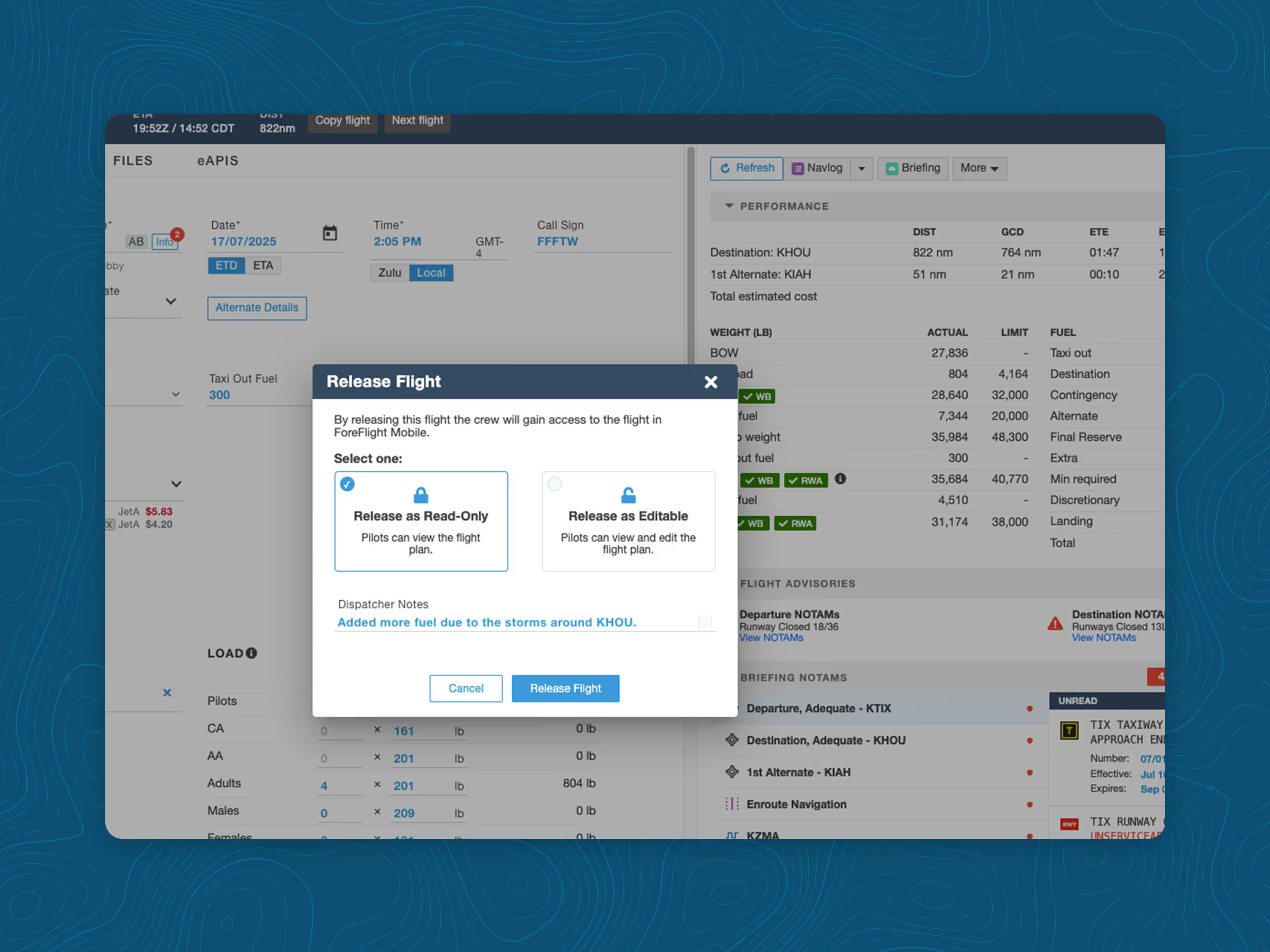Bridging the gap between flight planners and pilots

Ask yourself this question: “How long would it take me to make a simple change for a flight set to depart in the next hour?” If the answer is more than 60 seconds, disconnected systems may be creating bottlenecks that slow down your operation. Business aviation requires seamless coordination between flight planners, pilots, and operations teams. Yet most operations rely on fragmented systems that force them to work harder, juggling multiple platforms to answer basic questions about flight status.
Fragmented systems create friction that compounds throughout the day. When flight planners and crews use different systems, critical information gets trapped in silos, leading to delays, miscommunication, and increased workload for everyone involved. Without real-time synchronization between planning and execution, even experienced teams are stuck playing catch-up.
In this blog, we’ll explore how ForeFlight Dispatch eliminates these coordination challenges by creating a single environment where your team works from the same real-time information, enabling faster decision-making and safer flight operations.
Common pain points in traditional flight planning
Operating an aircraft fleet with disconnected systems creates predictable challenges that compound as your operation grows. While individual platforms excel at their specific functions, the gaps between them become bottlenecks that consume time, create confusion, and increase the risk of errors.
Information moves slowly through disconnected systems
Information moves slowly when it has to pass through multiple people and systems. Your flight planner updates the departure time in your scheduling system, but the flight crew doesn’t see the change unless they log into the same system or get a phone call from someone on the team notifying them of the change. Meanwhile, your flight planning system still displays the original departure time, and your client receives conflicting information about when their flight departs.
These communication delays become critical when dealing with time-sensitive changes. A storm cell moving through your departure airport requires immediate coordination between dispatch, pilots, and ground handling. But when your team works from different systems and time zones, coordination becomes a giant game of telephone. By the time everyone has the same information, you’ve lost valuable decision-making time.
Managing multiple flights with different departure times, routes, and crew requirements means operations teams spend more time coordinating information than making critical decisions.
Manual processes create operational risks
When systems don’t communicate automatically, your team becomes the connection between these platforms. Flight planners have to copy route information from one platform to another, manually enter passenger counts and baggage for weight and balance calculations, and coordinate fuel requirements between planning tools and crew briefing systems.
Each manual entry opens the door for critical data errors. A transposed number in a fuel calculation, an incorrect departure time, or a missed update to a passenger manifest can cascade into larger operational issues. Of course, you can put systems in place to verify and check for errors, but that takes even more time and doesn’t eliminate the underlying issue.
Lack of real-time operational visibility
Without integrated systems, getting a complete picture of your operation requires checking multiple platforms and manually verifying information. An operations manager needs to log into the scheduling system to see departure times, check the flight planning system for route information, and check a third-party system to track en route flights.
This type of fragmentation causes operations to be reactive rather than proactive. Identifying potential conflicts or areas that can be optimized before they’ve already passed becomes increasingly challenging. You might have two aircraft departing for nearby destinations at similar times, but since the information lives in different systems, nobody realizes they could coordinate ground transportation or handling services.
This lack of centralized visibility slows your response time when unexpected events occur. And without integrated systems, coordination happens through phone calls and manual checks rather than real-time notifications and data syncing.
Collaboration in action
The actual test of any operational system comes when things don’t go according to plan. Here’s how ForeFlight Dispatch and Mobile work together to handle common scenarios in business aviation operations.
Flight release workflows
A flight planner completes a last-minute flight in Dispatch at 7:00 AM for a 10:00 AM departure. Everything pertaining to the flight is done within Dispatch: the route, calculating performance data, weather briefing, and updating the passenger manifest. Once the flight planner saves and releases the flight, the crew can instantly view everything within ForeFlight Mobile. The pilots review the briefing on the way to the airport and are prepared when they arrive at the aircraft.
When one of the pilots realizes the aircraft is 200 pounds heavier than expected due to additional baggage, they update the weight in ForeFlight Mobile. Performance calculations are automatically updated and synced back to ForeFlight Dispatch, informing the flight planner that a change has been made.
With ForeFlight Dispatch and Mobile, the release process is a collaborative workflow rather than a series of separate handoffs where critical information could be missed.

Managing real-time changes
At 2 PM, your Teterboro-to-Cincinnati flight is approaching a thunderstorm that requires a significant reroute and will delay the departure of the next leg. Using Tracking, you can quickly identify this and leverage Dispatch to find a route for your flight crew to make up time on the next flight. Your flight planner sends the updated route through Dispatch, which immediately appears in ForeFlight Mobile for the crew.
Meanwhile, the operations team maintains complete visibility into the situation. They can see the weather affecting the flight, track the updated route progress, and proactively inform the FBO at the destination airport of the updated arrival time.
Enhanced decision-making through integration
ForeFlight Dispatch doesn’t force you to abandon the tools that are already working for your operation. Instead, it connects with your existing scheduling software, safety management systems, and other third-party systems to create a seamless ecosystem. When your scheduling system creates a flight for next Tuesday, that flight automatically appears in Dispatch, ready to be planned and released to your crew.
This connected approach means your team spends less time managing information and more time making important decisions. When your tools work together seamlessly, the effect goes beyond convenience; it transforms how your operation functions.
The operational advantage
When flight planning, crew coordination, and operational oversight happen within a single ecosystem, the benefits extend beyond eliminating duplicate data entry. Organizations using ForeFlight Dispatch improve efficiency, safety margins, and team coordination in measurable ways that compound over time.
Enhanced safety and operational trust
Standardized workflows across your entire operation reduce the variability that leads to errors. When every flight planner uses the same procedures in Dispatch and every pilot receives information in the same format through ForeFlight Mobile, your operation becomes more predictable and reliable. New team members can quickly adapt to established procedures rather than learning multiple systems with different interfaces and workflows.
The digital trail is also much easier to follow as flight plans, weight and balance calculations, and navlogs are automatically documented with signatures and timestamps. If regulatory authorities request records, you have complete documentation of everything you need at the click of a button.
Scalability and operational consistency
Growing flight operations often struggle with consistency as they add new aircraft, crew members, and destinations. By having everything in a single ecosystem, standardization scales as your fleet grows. Whether you’re managing two or twenty aircraft, the procedures are more or less the same, and crew members encounter familiar workflows regardless of which aircraft they fly.
Cost optimization and strategic planning
Integrated fuel planning and route optimization capabilities help identify cost savings that aren’t always apparent in fragmented systems. When fuel prices, aircraft performance data, and route planning exist in the same platform, your team can easily identify opportunities for optimizing fuel uplifts at lower-cost airports or modify routes to reduce overall trip expenses.
This data also enables better strategic planning for fleet utilization and route efficiency. Instead of manually compiling reports from multiple systems, operations managers can analyze past flight activity in a single platform.
How ForeFlight Dispatch connects teams for faster, safer flights
Multi-aircraft operations don’t have to mean multi-system complexity. ForeFlight Dispatch transforms the coordination challenges we’ve discussed by creating a single source of truth where flight planners, pilots, and operations team members work from the same real-time information.
Built for your existing workflow
If your pilots already use ForeFlight Mobile, adding Dispatch creates immediate operational benefits with a minimal learning curve. Most operations are up and running within days. For operations using other systems, Dispatch’s integration capabilities mean you can maintain the specialized tools that already work for you, while still gaining the benefits of having everything in a single platform.
Your scheduling software, safety management systems, and other third-party systems connect directly into Dispatch, creating visibility without disrupting workflows.
Transform your operation
Ready to eliminate the coordination challenges that slow down your operation? See how ForeFlight Dispatch can connect your team and streamline your operations.
Visit our website to discover the impact ForeFlight Dispatch can have on your operation.





